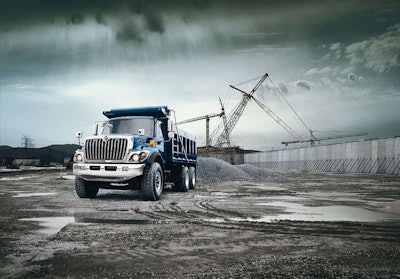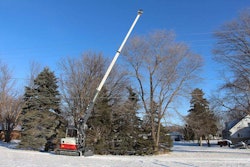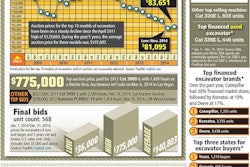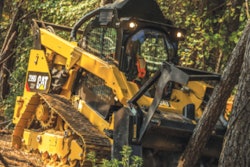 Navistar’s International WorkStar vocational truck
Navistar’s International WorkStar vocational truckIf you follow me on Twitter, you know I spent a day this week at Navistar’s Financial Meeting, where the company explained to Wall Street analysts and trucking journalists how things are going these days.
The company just wrapped up year two of its urgent turn-around program, instituted after its Exhaust Gas Recirculation-only (EGR) emissions strategy failed to materialize. To be fair, if the strategy had worked, it would have been a game-changer. But Navistar’s previous management team, headed by president Dan Ustian, kept trying to pound a square peg into a round hole far too long after it was apparent EGR-only wasn’t viable.
RELATED: Now you can order a new International WorkStar with a Cummins ISB6.7
And, it should be remembered, Ustian’s regime made other questionable business decisions, with alienating Ford and ultimately losing its highly popular PowerStroke mid-range diesel business being pretty high up on the list.
To use a football analogy, by the end of Ustian’s reign, you got the feeling Navistar was on its own 30 yard line, frantically slinging Hail Marys into the end zone hoping for a miracle before the clock runs out.
Today, under the new leadership team headed by CEO Troy Clarke and President Bill Kozek (who came off the bench from PACCAR), you sense a team that’s established a solid ground game and is determinedly running the ball up the middle. They haven’t gotten as many first downs as they’d like. But they are moving the ball in the right direction. And now, as their field position has improved somewhat, it looks like they’re going to start throwing a few passes downfield.
With all that in mind, here a few take-aways I gathered during my day with Kozek and his crew up in Lisle, Ill.:
- Warranty claims connected to 2010 EGR-only engines (which the company calls “legacy” engines) have peaked. They are still working through claims but they believe this particular drag on their finances will ease significantly this year.
- Speaking of the 2010 engines, one major aspect of this turn-around has been a major re-engineering effort of 2010 EGR emissions systems to make them easier and cheaper for fleets to replace and repair.
- At the same time, the company has doubled down on improved quality and uptime, both for vehicles already sold and new products. Navistar says this effort has yielded measurable reliability gains. This initiative (and the bullet point above) are clear signs that the company understands how far it must go in order to gain back customer confidence.
- Navistar is still in the engine business. For now. With any lingering reliability issues resolved and integration of Selective Catalytic Reduction emissions throughout its MaxxForce 13 liter engine line almost complete, Clarke says Navistar is set to compete in the heavy-engine market at least until 2020. At that point, though, some tough decisions will have to be made. It costs hundreds of millions – if not billions – of dollars to develop heavy-duty diesel engine platforms today. And one unavoidable consequence of the company’s current outflow of cash may be that it simply doesn’t have the money on hand to invest in new engine technology when that becomes imperative. Five years is a long time in the world of trucking. So nothing is carved in stone on this issue. But I’d say this is strong indication the relationship between Cummins and Navistar will only get stronger (with much higher levels of powertrain-vehicle integration) in the short term.
- Vertical integration is out. Customer choice is in. Navistar recognizes that it will need strong relationships with key industry suppliers to compete. This means that while other OEMs attempt to steer customers toward captive components and technology, Navistar will be partnering with suppliers to make sure they are giving customers access to the latest and best technology available. To do that, the company is bolstering its relationships in the industry and its engineering teams have already been working closely with suppliers to ensure seamless product integration. And while it’s true that Navistar really doesn’t have any choice but to go with this strategy now, they are making the right moves with the right companies to do this the right way. And it’s a concept that will appeal to a lot of their customers.
- While Navistar listed an impressive array of cost-cutting measures it has initiated to staunch its financial losses, a lot of the company’s problems – and its bottom line — would be dramatically improved by selling trucks. And Koezek is determined to start doing exactly that. Even with all its challenges, this is a company that notably did not put new product development on hold during the dark times. The new, aerodynamic-optimized ProStar ES is a damn good-looking truck, and exactly the tractor Navistar needs to compete with fuel-focused fleets today. While admitting that Navistar has not recaptured marketshare as quickly as it would have liked, Kozek is on record that he intends to sell 1,000 more Class 8 trucks in 2015 than in 2014. And he’s banking on seriously revitalized vocational and medium-duty demand to help him put another 4,000 to 5,000 units on the road in those markets. Those are aggressive goals. But hitting them would be a major milestone on Navistar’s road to recovery.









